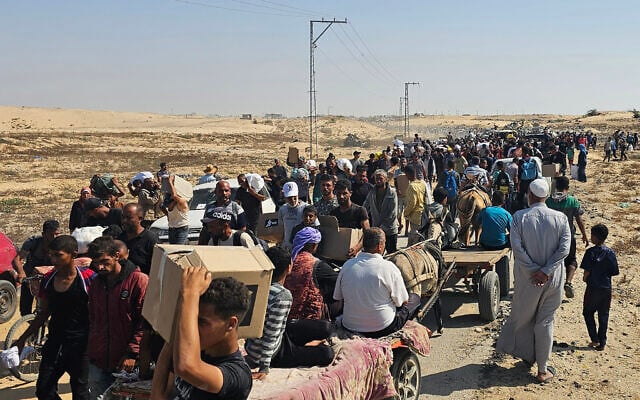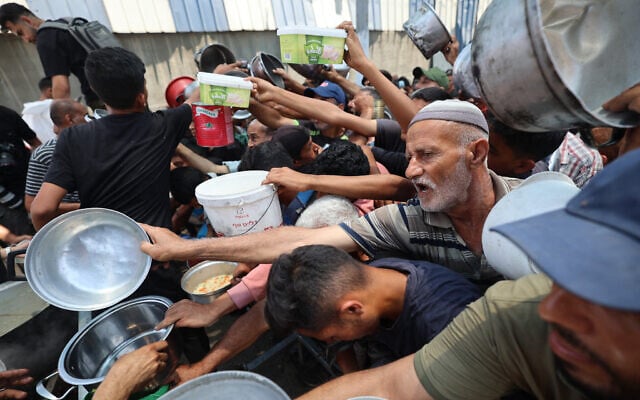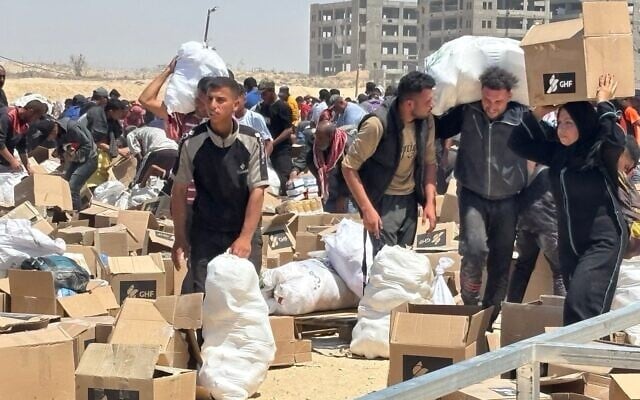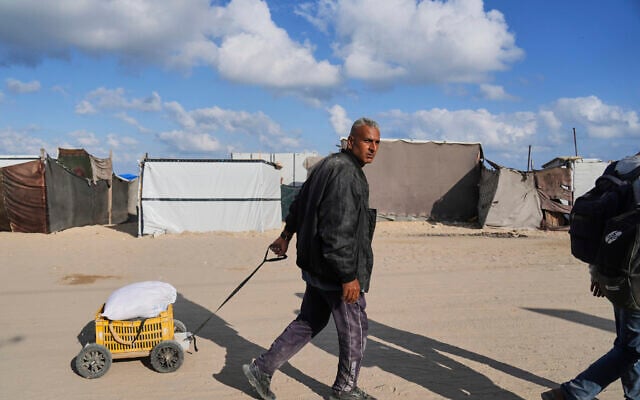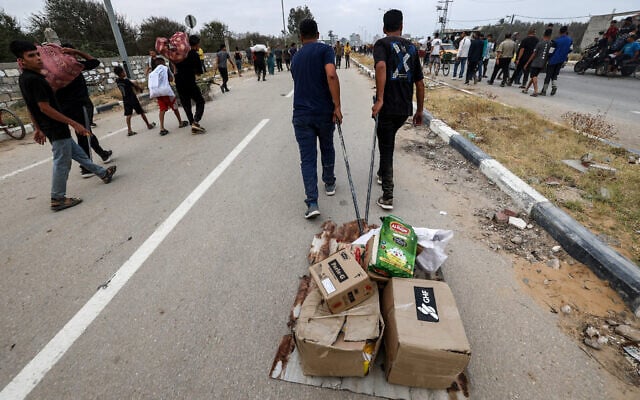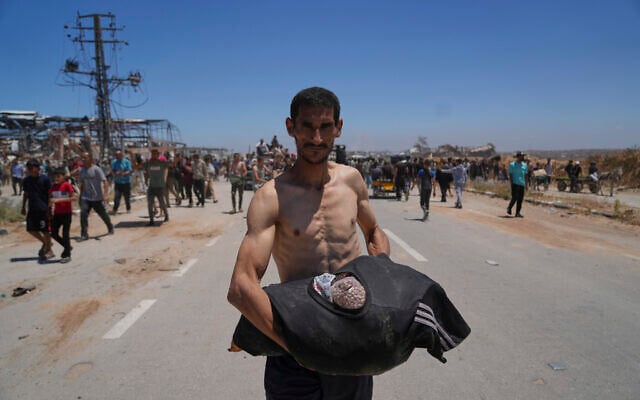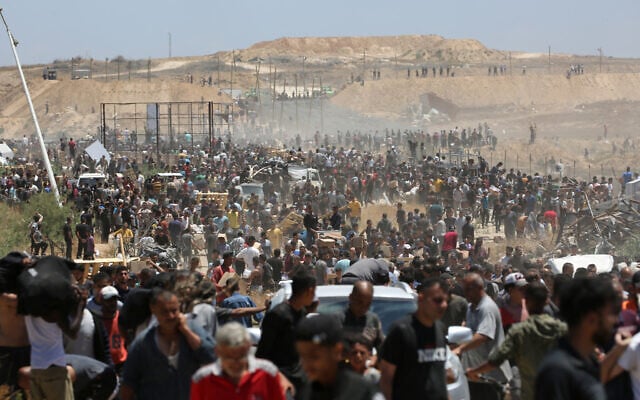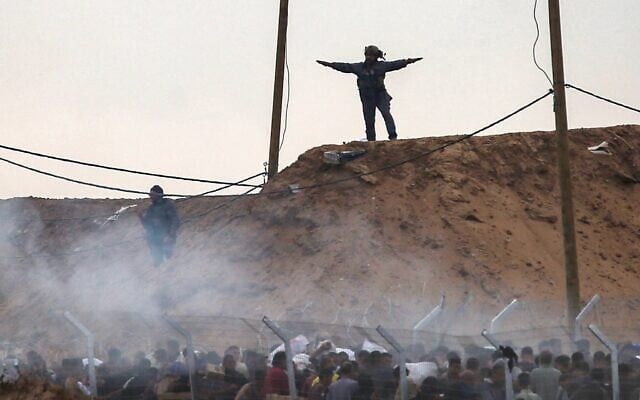


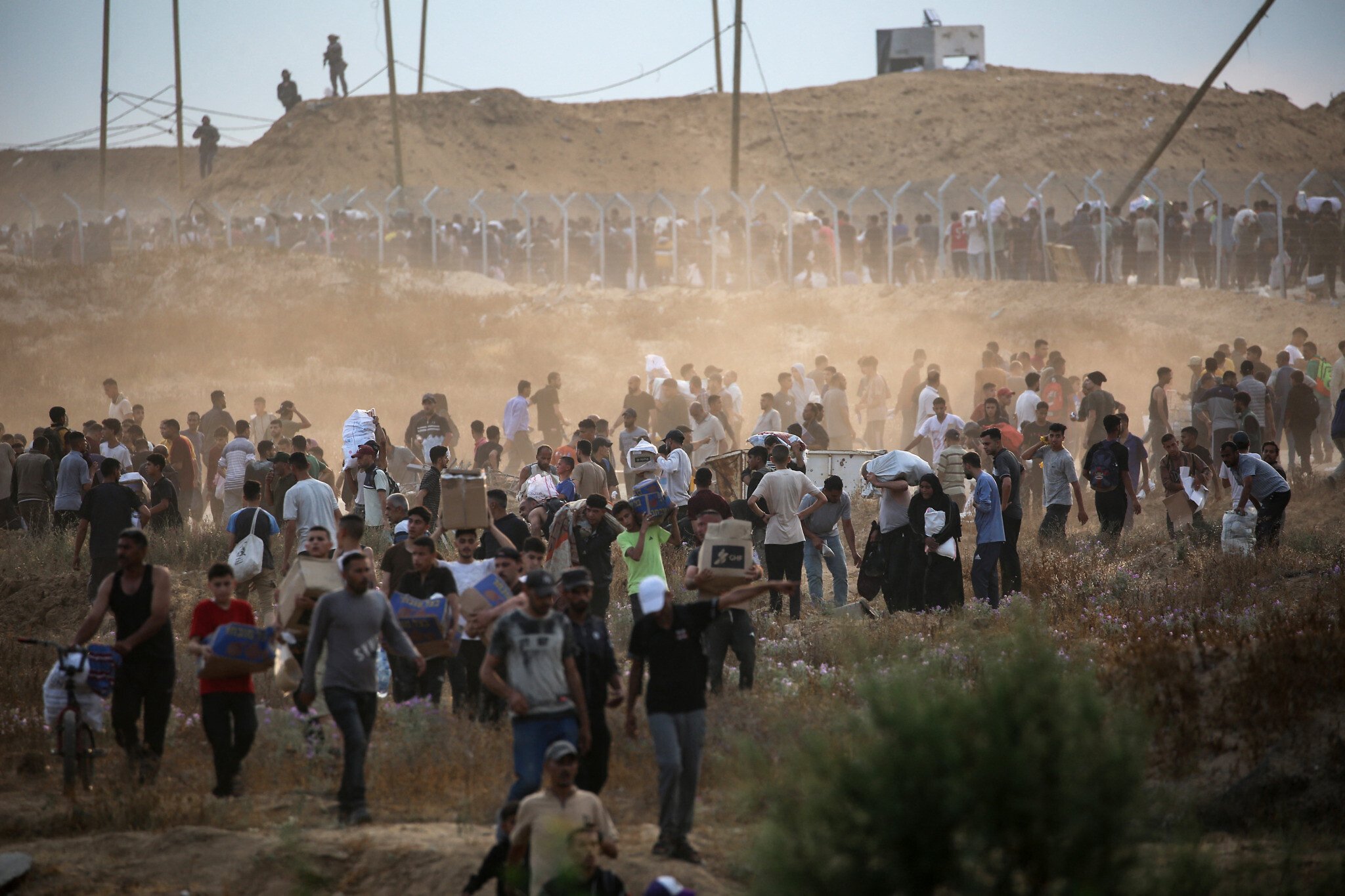
Testimony and footage from Gaza show that newly opened aid distribution centers are plagued by logistical and security problems amid a lack of organization and oversight, making it difficult and dangerous for Gazans to pick up packages of food.
The centers are operated by the Gaza Humanitarian Foundation (GHF), a US- and Israel-backed initiative that has boasted of handing out millions of meals to Gazans. However, many aspects of the organization and its operations are shrouded by secrecy or clouded by a lack of transparency, making it impossible to verify its claims, amid significant questions about how effective its work has been.
The foundation says it is operating four distribution sites in Gaza, and has promised to open more, though it has struggled to keep even those four operating due to logistical and security issues. The sites are fenced in and located in areas where the Israeli military has taken over and forced civilians out of, meaning Gazans must travel long distances across Israel Defense Forces lines to reach the aid.
Though Israel disputes the high death tolls reported in shooting incidents outside of aid centers, apparently due to soldiers firing on crowds trying to reach the sites, there seems little doubt that making the journey is fraught with danger for Gazan civilians.
Speaking to The Times of Israel via WhatsApp, a Gazan man said he avoids going to the centers because they are too far and the roads are dangerous.
“Why would I expose myself to danger?” asked the man, who requested anonymity due to fears for his safety. “The roads are dangerous, the type of aid is unclear and it’s very crowded there.”
The spokesperson for the Gaza Humanitarian Foundation did not respond when contacted for comment by The Times of Israel. A list of questions sent to an email address maintained by the group for media inquiries was not answered.
Israel began allowing food, medicine and other assistance to trickle back into the Strip on May 18, after a 78-day blockade that had brought the enclave to the brink of starvation.
At the time, Prime Minister Benjamin Netanyahu cited concerns over hunger in the Strip as some in his government protested allowing aid to resume before GHF was ready to begin working, and it is unclear if the foundation and the Israeli military were in fact prepared by May 26, when GHF announced the opening of its first distribution center.
According to Israel, as of June 8, over 1,200 truckloads of aid had been allowed into the Strip. The figure includes assistance earmarked for distribution via the World Food Program and other UN-affiliated humanitarian organizations, which have operated throughout the 20-month war. It also includes trucks carrying boxes of food being handed out by GHF.
The new initiative has been hounded by controversy even since before it officially began operations. Though officially independent, the mechanism was set up with American and Israeli backing as a way to get aid to Gazans in a way that did not leave the goods vulnerable to being stolen by Hamas, which allegedly sold them on the black market to fund its continued operations.
The UN, which denies any systematic diversion of aid away from civilians, has vociferously opposed GHF’s operations, saying it is unable to meet mounting needs and allows Israel to use aid as a weapon by determining who can receive it. Critics, including much of the international community, have also accused GHF of putting aid seekers in harm’s way by placing the aid centers in IDF-controlled zones.
GHF has noted that among its critics is also Hamas, the terror group ruling the Gaza Strip, which Israel is fighting to remove from power following its October 7, 2023, onslaught into southern Israel.
According to GHF, Hamas threats directed at the foundation’s drivers and at local Palestinian staff helping operate the distribution sites forced it to shutter operations on Saturday.
On Monday, GHF said it suspended operations again, though only at one of three facilities, a distribution site in Rafah’s Tel Sultan neighborhood, blaming the “chaos of the crowds.”
Indeed, footage of the sites points to chaos and crowds being regular features of GHF distribution.
Videos and pictures, including some published by GHF itself, show little order to the distribution of aid inside the fenced-off sites. One clip from May 31 shows a veritable free-for-all at a site in Rafah, with hundreds of Gazans rushing toward aid and grabbing packages as quickly as they can.
No registration, verification, or organized distribution is apparent, with the process seemingly open to the uneven distribution of aid, despite GHF gently requesting that desperate Gazans stick to a one-box-per-family limit.
A system of fences apparently meant to help organize lines of recipients appear to be largely ignored in some footage, with Gazans flowing in, out and over them.
“The main problem is the mechanism. There is no organized process in the distribution centers — whoever shows up just takes aid,” a Gazan told The Times of Israel. “For comparison, the World Food Program takes down names and phone numbers, and families get an SMS with their scheduled pickup time. The American company doesn’t do that. If you arrive late, you don’t get aid. There’s no screening, no supervision, no name registration. There’s no mechanism to ensure that once you’ve received aid, you can’t come again.”
The only source of information regarding how much humanitarian aid is being distributed at the centers comes from GHF itself, which claimed Monday to have distributed over 192,000 boxes of food over the previous two weeks.
According to GHF, which employs inconsistent math in daily statements about its distribution efforts, each box contains nearly 58 meals, which it says is enough to feed 5.5 people for 3.5 days.
However, GHF does not provide Gazans with ready-to-eat meals, as aid groups recommend in such humanitarian crises. Instead, the boxes are filled largely with dry food products that require cooking equipment to prepare. The nutritional value of the boxes is not disclosed, and there are questions over the uniformity of the aid packages.
Many of the products appear to come from Israeli factories, with Hebrew labels and kosher markings. Gazans also appear to find the use of cardboard boxes inconvenient for transporting the heavy products over the long trek back to their homes or tents. Footage of areas around aid sites usually shows the ground littered with cardboard as people transfer the goods into sacks for the long walk back.
“People walk on foot,” a Gazan told The Times of Israel via Zoom. “There are no cars and no fuel. Some ride animals.”
It’s common for sites to run out of aid, sometimes within an hour of opening, leaving crowds of angry and disappointed Gazans.
“I went there at 2 a.m., hoping to get some food. On my way there, I saw people returning empty-handed. They said aid packages have run out in five minutes. This is insane and isn’t enough,” Gazan Mohammad Abu Amr, 40, told Reuters on Tuesday with a chat app. “Tens of thousands arrive from the central areas and from the northern areas too, some of them walked for over 20 kilometers (12 miles), only to come back home with disappointment.”
GHF communicates with the Palestinian population largely through an Arabic Facebook page where it publishes updates on which sites will open and when. But the posts often aren’t published until the last minute, giving Gazans little time to prepare for the long trek to the distribution sites.
According to one Gazan who spoke to The Times of Israel, information about openings is sometimes only spread via word of mouth.
“There’s no clear way to get information,” he said. “People get updates from the American on site. Displaced people staying near the centers are told by officers: ‘We’re opening the gate.'”
The foundation has urged recipients not to show up early, warning that the access routes are not safe when the sites are not open. Last week, the IDF warned Palestinians not to approach routes leading to GHF sites between 6 p.m. and 6 a.m. local time, describing these roads as closed military zones.
GHF’s first two weeks of operations have been replete with near-daily reports and video clips of recipients coming under fire as they make the trip to the distribution centers.
The Red Cross and Hamas-linked authorities in the Strip have claimed the IDF has been behind the gunfire, claiming dozens killed and hundreds wounded over the past two weeks. The IDF has admitted to firing warning shots at those who have strayed from the military-approved paths for reaching the sites, but has asserted that Hamas has inflated the death counts from these incidents.
On Monday, witnesses said members of a local militia allied with Israel opened fire on people trying to reach a GHF site, with Gazan health authorities claiming 10 were killed.
The Abu Shabab group, which calls itself the Popular Forces, says it is guarding the surroundings of the GHF centers in southern Gaza. Aid workers say it has a long history of looting UN aid trucks. GHF has said it does not work with the Abu Shabab group, which Israel has admitted to arming.
GHF has sought to distance itself from the shootings, claiming that there have been no injuries or clashes at its sites.
Footage last month showed the environs guarded by what appeared to be heavily armed American defense contractors in military gear, who were seen stopping crowds of Gazans attempting to reach a distribution site.
However, neither Israel nor the Gaza Humanitarian Foundation has disclosed who is operating the facilities.
According to testimonies and videos, some of the guards are employees of UG Solutions, a small US defense contractor that has also been involved in guarding checkpoints in Gaza.
A job listing posted online by UG Solutions for a mission “securing key infrastructure [and] facilitating humanitarian efforts” said the company was seeking former special forces soldiers, SWAT police and other law enforcement officers with combat experience.
The listing also sought “Arabic speakers with Egyptian, Jordanian, Iraqi and Lebanese dialects.”
In videos, armed guards are seen struggling to communicate with crowds of Gazans about the site’s closure and when it will re-open, with one saying “Tomorrow at 10 a.m.” in American-accented English.
In another video recorded by a Gazan on May 29, a man films himself after receiving an aid package, alongside an armed individual who speaks English with an American accent.
US contractor Safe Reach Solutions has also been reported to be involved in GHF operations. A job listing posted by SRS lists various qualifications, including Arabic proficiency and experience with major international NGOs, for a role supporting a humanitarian operations center in an active combat zone somewhere in the Middle East.
There is also evidence that some involved with the operation may come from the Gulf. While Gulf states have not announced any support for or cooperation with the program, at least one clip from a distribution center shows a worker speaking to Gazans in Gulf-accented Arabic.
In footage aired by the Qatari Al-Araby channel, a Gazan resident who received aid at the Rafah center on May 28 said that most of the workers are Arabs, but there are also a few Americans. He added that IDF forces are stationed near the compound.
Though registered in the United States and officially run by American evangelical leader Johnnie Moore, a New York Times investigation has revealed that GHF was the brainchild of Israeli reservists and businessmen.
Documents published by Israel’s Kan public broadcaster indicate that, contrary to government claims, the food distributed under the program is at least partially funded by the State of Israel, using money previously allocated to the Defense Ministry’s budget.
In response to the Kan report, the Prime Minister’s Office and Finance Ministry issued a joint statement denying that Israel was funding any humanitarian aid going into Gaza.
Jacob Magid, Lazar Berman and Times of Israel staff contributed to this report.

